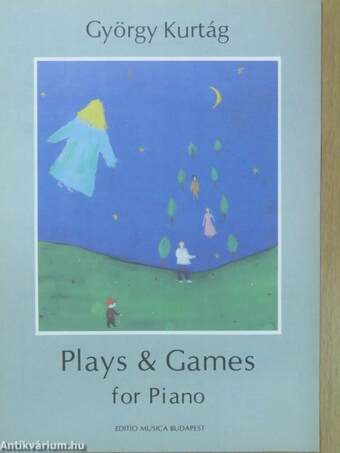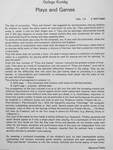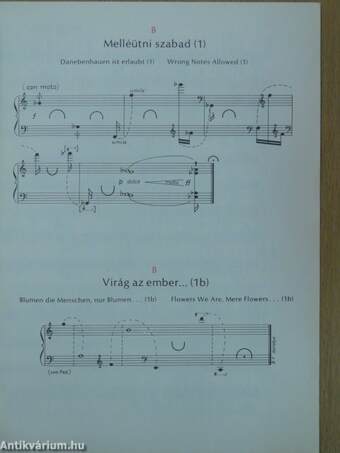1.067.715
kiadvánnyal nyújtjuk Magyarország legnagyobb antikvár könyv-kínálatát

VISSZA
A TETEJÉRE
JAVASLATOKÉszre-
vételek
Plays & Games for Piano
Játékok zongorára - Kotta
| Kiadó: | Editio Musica |
|---|---|
| Kiadás helye: | Budapest |
| Kiadás éve: | |
| Kötés típusa: | Tűzött kötés |
| Oldalszám: | 7 oldal |
| Sorozatcím: | |
| Kötetszám: | |
| Nyelv: | Magyar Angol Német |
| Méret: | 30 cm x 21 cm |
| ISBN: | |
| Megjegyzés: | Kotta. |
naponta értesítjük a beérkező friss
kiadványokról
naponta értesítjük a beérkező friss
kiadványokról
Fülszöveg
György Kurtág Plays and Games Vols. 1-4 Z 8377-8380 The idea of composing "Plays and Games" was suggested by spontaneously playing children. By children for whom the piano means an instrument for play yet. They experiment with it, caress it, attack it.and run their fingers over it. They pile up seemingly disconnected sounds and if this play happens to arouse their musical instinct they look consciously for somé of the harmonies found by chance and keep repeating them. To write all this down was a play for the composer, too. A play with the instrument, tones and sound effects, with rhythm and movement, restriction and freedom. In the course of composition somé ideas took the shape of a piece of full value, others that of an exercise while somé of them became a mixture of the two: less than a piece but more than a mere study. Thus this series does not provide a tutor, nor does it simply stand as a collection of pieces but rather as a possibility for playing which should be used for... TovábbFülszöveg
György Kurtág Plays and Games Vols. 1-4 Z 8377-8380 The idea of composing "Plays and Games" was suggested by spontaneously playing children. By children for whom the piano means an instrument for play yet. They experiment with it, caress it, attack it.and run their fingers over it. They pile up seemingly disconnected sounds and if this play happens to arouse their musical instinct they look consciously for somé of the harmonies found by chance and keep repeating them. To write all this down was a play for the composer, too. A play with the instrument, tones and sound effects, with rhythm and movement, restriction and freedom. In the course of composition somé ideas took the shape of a piece of full value, others that of an exercise while somé of them became a mixture of the two: less than a piece but more than a mere study. Thus this series does not provide a tutor, nor does it simply stand as a collection of pieces but rather as a possibility for playing which should be used for playing and not for learning "to play the piano". From the four volumes of "Plays and Games" volume I contains the greatest number of exercises. They serve as a kind of introduction into the sound of "Plays and Games" as an aid to reading notes and to solving the technical difficulties inherent in the pieces. They do not contain all the difficulties that will occur but give merely ideas to practising in a playful manner, to improvisation and incidentally to composing small pieces (see the piece of the six-year old Kriszta Takács). The criterion of arrangement in volume I is: A (left) page - free movement with clusters, with tones not defined precisely B (right) page - precisely defined tasks The arrangement of the four volumes is so as to fali into line with the increasing musical and technical requirements. Due to musical aspects certain easier pieces have, however, been shifted further back while more difficult ones have been put ahead. It is, nevertheless, important to know that a great number of pieces may be performed at any level partly because the piece can be rendered in a different tempó and style as well (e.g. Perpetum mobile, Flowers We are Plam-Stroke/1, Plam-Stroke/2 etc.). With the frequently occuring "Hommage" the composer portrays outstanding personalities or their work. Several pieces refer to earlier works of the composer, most of them to the Sayings of Peter Bornemisza (e.g. Flowers We are ..., The Mind will have its Freedom) and to the four songs to poems by Pilinszky (e.g. Beating, Study to "Hölderlin"). One type of the pieces for four hands is strictly defined (e.g. Hoquetus). Timbre, dynamics and touch should appear as if only a single player were playing. As a counterpart of this kind of pieces for four hands we find the free ones. Primo and secondo are not written under each other for the tempó, dynamics and performance style of the parts are independent from one another. To perform such pieces it is, however, required that the partners have a creative, sensítive attitűdé to chamber music playing. By revealing a profound knowledge of the children's soul, by their inexhaustible variety, poeticalness and humour including gentle serenity, caricature and even grotesque quality "Plays and Games" introduce us into the musical, technical and formai beauty of new music. Marianne Teöke VisszaTémakörök
- Idegennyelv > Idegennyelvű könyvek > Többnyelvű könyvek
- Művészetek > Zene > Komolyzene > Kották > Hangszer szerint > Zongora
- Művészetek > Zene > Komolyzene > Idegen nyelv > Egyéb
- Művészetek > Zene > Komolyzene > Kották > Egyéb
Megvásárolható példányok
Nincs megvásárolható példány
A könyv összes megrendelhető példánya elfogyott. Ha kívánja, előjegyezheti a könyvet, és amint a könyv egy újabb példánya elérhető lesz, értesítjük.






